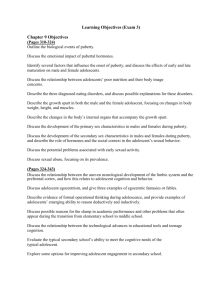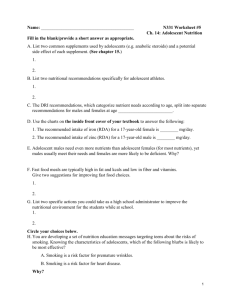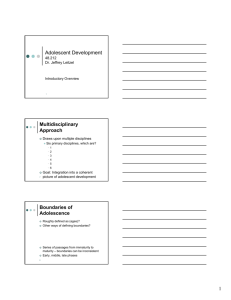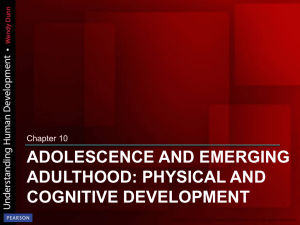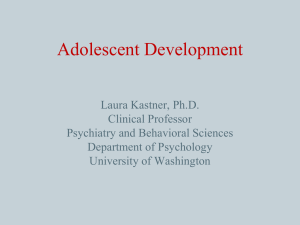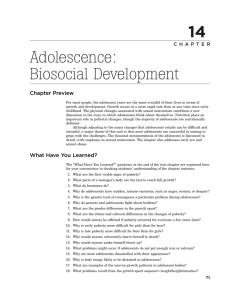Chapter One: Intro/Methods Learning Objectives & Essay Questions
advertisement
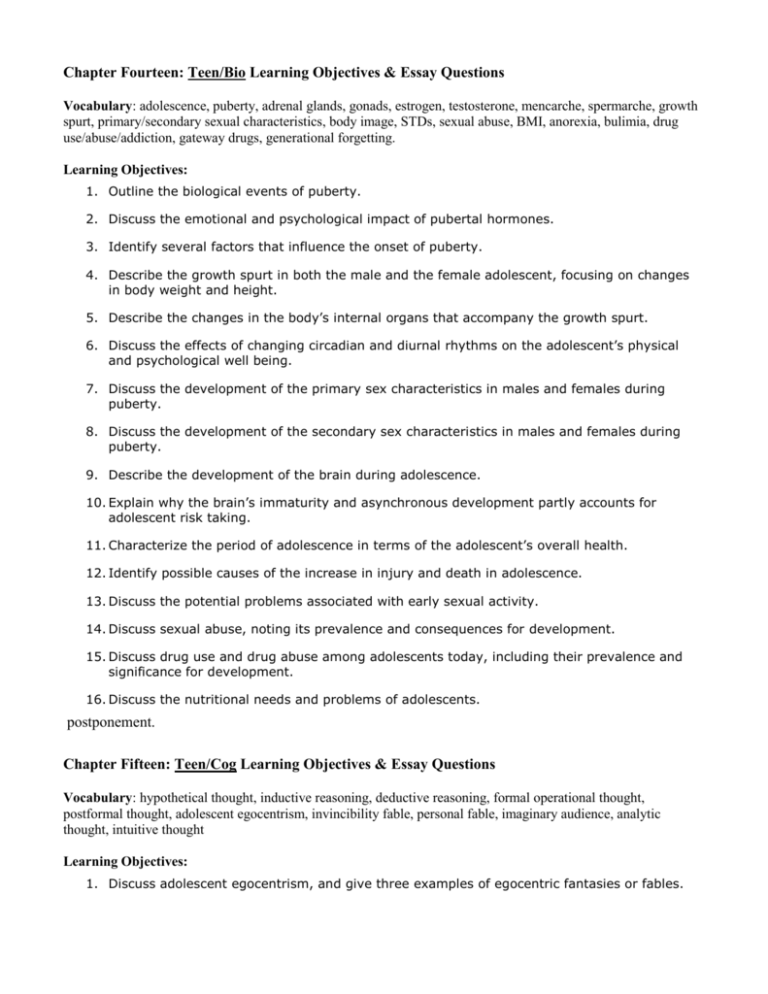
Chapter Fourteen: Teen/Bio Learning Objectives & Essay Questions Vocabulary: adolescence, puberty, adrenal glands, gonads, estrogen, testosterone, mencarche, spermarche, growth spurt, primary/secondary sexual characteristics, body image, STDs, sexual abuse, BMI, anorexia, bulimia, drug use/abuse/addiction, gateway drugs, generational forgetting. Learning Objectives: 1. Outline the biological events of puberty. 2. Discuss the emotional and psychological impact of pubertal hormones. 3. Identify several factors that influence the onset of puberty. 4. Describe the growth spurt in both the male and the female adolescent, focusing on changes in body weight and height. 5. Describe the changes in the body’s internal organs that accompany the growth spurt. 6. Discuss the effects of changing circadian and diurnal rhythms on the adolescent’s physical and psychological well being. 7. Discuss the development of the primary sex characteristics in males and females during puberty. 8. Discuss the development of the secondary sex characteristics in males and females during puberty. 9. Describe the development of the brain during adolescence. 10. Explain why the brain’s immaturity and asynchronous development partly accounts for adolescent risk taking. 11. Characterize the period of adolescence in terms of the adolescent’s overall health. 12. Identify possible causes of the increase in injury and death in adolescence. 13. Discuss the potential problems associated with early sexual activity. 14. Discuss sexual abuse, noting its prevalence and consequences for development. 15. Discuss drug use and drug abuse among adolescents today, including their prevalence and significance for development. 16. Discuss the nutritional needs and problems of adolescents. postponement. Chapter Fifteen: Teen/Cog Learning Objectives & Essay Questions Vocabulary: hypothetical thought, inductive reasoning, deductive reasoning, formal operational thought, postformal thought, adolescent egocentrism, invincibility fable, personal fable, imaginary audience, analytic thought, intuitive thought Learning Objectives: 1. Discuss adolescent egocentrism, and give three examples of egocentric fantasies or fables. 2. Discuss possible reasons for the slump in academic performance and other problems that often appear during the transition from elementary school to middle school. 3. Describe evidence of formal operational thinking during adolescence, and provide examples of adolescents’ emerging ability to reason deductively and inductively. 4. Explain adolescents’ use of illogical, intuitive thought even when they are capable of logical thought. 5. Evaluate the typical secondary school’s ability to meet the cognitive needs of the typical adolescent. 6. Discuss three potential problems that stem from the mismatch between the typical high school environment and adolescents’ needs. 7. Identify the main characteristics of postformal thought, and describe how it differs from formal operational thought. 8. Discuss the relationship between cognitive growth and higher education. Chapter Sixteen: Teen/Soc Learning Objectives & Essay Questions Vocabulary: identity, possible selves, false self, identity vs. role confusion, identity achievement, foreclosure, negative identity, identity diffusion, identity moratorium, gender identity, rite of passage, suicidal ideation, parasuicide, cluster suicide, internalizing problems, externalizing problems, incidence, prevalence, adolescencelimited offender, life-course limited offender, generational gap, parental monitoring, peer pressure Learning Objectives: 1. Describe the development of identity during adolescence. 2. Describe the four major identity statuses, and give an example of each. 3. Discuss the problems encountered in the formation of religious, gender, ethnic, and vocational identities, and describe cultural effects on identity formation. 4. Describe parental influence on identity formation, including the effect of parent–adolescent conflict and other aspects of parent–teen relationships. 5. Explain the constructive functions of peer relationships and close friendships during adolescence and the unique challenges faced by immigrants. 6. Discuss the development of male–female relationships during adolescence, including the challenges faced by gay and lesbian adolescents. 7. Discuss the various influences on teen sexual behavior, including schools, peers, and the media. 8. Discuss adolescent suicide, noting contributing factors and gender, ethnic, and national variations. 9. Discuss delinquency among adolescents today, noting its incidence and prevalence, significance for later development, and best approaches for prevention or treatment. 10. Describe the overarching theme of adolescent development
